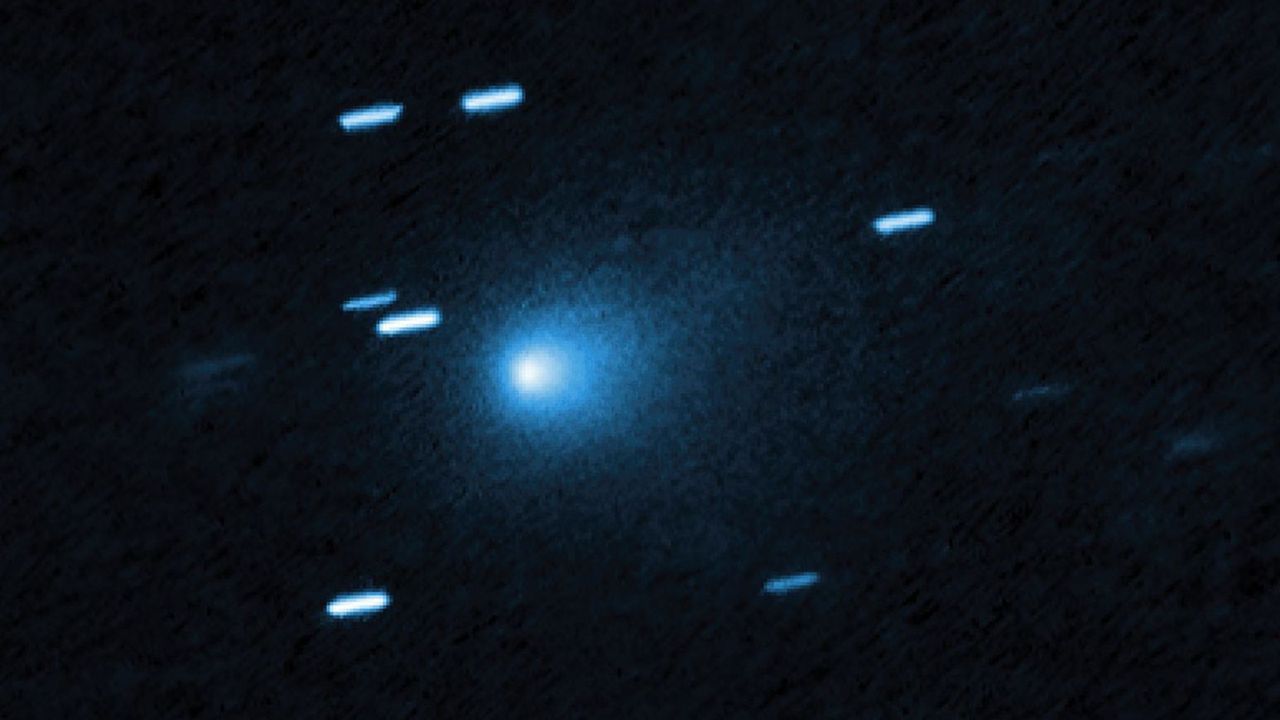Science
Astronomers Detect Unexpected Nickel in Comet 3I/ATLAS

A team of international astronomers has made a groundbreaking discovery involving the interstellar comet 3I/ATLAS, detecting glowing nickel vapor in its surrounding gas. This finding, which occurred at an extraordinary distance from the sun, challenges existing theories about the chemical processes at play in such frigid environments. The research offers new insights into the chemistry of materials from beyond our solar system.
The comet was first detected on July 1, 2025, during a routine sky survey by the Asteroid Terrestrial-impact Last Alert System (ATLAS). 3I/ATLAS is only the third confirmed interstellar object discovered, following the enigmatic ‘Oumuamua and comet 2I/Borisov. Unlike its predecessors, this comet was observed early in its journey, providing astronomers with a rare opportunity to study its chemical awakening as it nears the sun.
Tracking the Chemical Awakening
The discovery of 3I/ATLAS is significant because interstellar objects carry unique chemical and physical information from their star systems, potentially billions of years old. They function as cosmic time capsules, allowing scientists to study exoplanetary system materials that are otherwise inaccessible.
Using the Very Large Telescope (VLT) in Chile, the research team monitored the comet’s chemical evolution. Spectroscopic observations revealed a trajectory indicating that 3I/ATLAS formed long before our solar system, suggesting it may be significantly older than Earth itself.
As the comet approached the sun, the team observed a remarkable sequence of chemical activation. The first significant detection of nickel vapor occurred on July 20, 2025, at a distance of 3.88 astronomical units (AU) from the sun, nearly four times Earth’s distance. The unexpected presence of nickel at such a cold distance raised questions about the mechanisms behind its release.
By mid-August, when 3I/ATLAS was at approximately 3.07 AU, the team also detected cyanogen (CN) gas, a common emission in solar system comets. The increase in nickel vapor was notable, suggesting a substantial rise in the number of nickel atoms as the comet drew closer to the sun.
Unusual Chemical Signatures
The detection of nickel without a corresponding increase in iron is particularly intriguing. This chemical signature implies that nickel may be released through processes that operate at much lower temperatures. Normally, metals would require higher temperatures to vaporize directly, a process known as sublimation.
The findings suggest that nickel atoms could be bound within specific types of molecules that disintegrate when exposed to sunlight. These molecules might include compounds where nickel is attached to carbon monoxide or other organic materials, which could facilitate the release of nickel atoms at lower temperatures.
Data from the James Webb Space Telescope (JWST) complements these observations, revealing that the gas cloud surrounding 3I/ATLAS contains more carbon dioxide than water, a ratio that deviates from the norm observed in most solar system comets. The JWST also detected water ice particles and carbon monoxide gas in the coma of the comet, indicating a complex mixture of frozen materials that are becoming active as they warm.
The interplay between these chemical releases, especially with regard to nickel and iron, remains an area of ongoing analysis.
Implications for Astrophysics
As 3I/ATLAS continues its journey toward perihelion—the point of closest approach to the sun—set for October 29, 2025, the research team is poised to gather further data. The chemical signatures observed may not only shed light on the comet’s ancient origins but also help scientists understand whether the building blocks of planetary systems are consistent throughout the galaxy.
By comparing 3I/ATLAS with solar system comets and the previous interstellar visitor 2I/Borisov, researchers aim to create a more comprehensive understanding of the materials that contribute to planetary formation across different stellar environments.
The beauty of scientific inquiry lies in its ability to adapt and evolve based on new evidence. The discoveries surrounding 3I/ATLAS exemplify the complexity and richness of the universe, underscoring the importance of methodical research in unraveling cosmic mysteries.
The international team, comprised of scientists from countries including Chile, Belgium, the U.K., Canada, New Zealand, the United States, and Italy, will continue to monitor 3I/ATLAS as it approaches perihelion. With coordinated observations from ground-based telescopes and space observatories, they hope to uncover more secrets from this interstellar traveler before it exits our solar system, carrying with it its ancient materials into the vastness of space.
-

 Sports2 weeks ago
Sports2 weeks agoSteve Kerr Supports Jonathan Kuminga After Ejection in Preseason Game
-

 Politics2 weeks ago
Politics2 weeks agoDallin H. Oaks Assumes Leadership of Latter-day Saints Church
-

 Lifestyle2 weeks ago
Lifestyle2 weeks agoKelsea Ballerini Launches ‘Burn the Baggage’ Candle with Ranger Station
-

 Lifestyle2 weeks ago
Lifestyle2 weeks agoDua Lipa Celebrates Passing GCSE Spanish During World Tour
-

 Entertainment2 weeks ago
Entertainment2 weeks agoZoe Saldana Advocates for James Cameron’s Avatar Documentary
-

 Business2 weeks ago
Business2 weeks agoTyler Technologies Set to Reveal Q3 2025 Earnings on October 22
-

 Science2 weeks ago
Science2 weeks agoChicago’s Viral ‘Rat Hole’ Likely Created by Squirrel, Study Reveals
-

 Health2 weeks ago
Health2 weeks agoRichard Feldman Urges Ban on Menthol in Cigarettes and Vapes
-

 World2 weeks ago
World2 weeks agoD’Angelo, Iconic R&B Singer, Dies at 51 After Cancer Battle
-

 Business2 weeks ago
Business2 weeks agoMLB Qualifying Offer Jumps to $22.02 Million for 2024
-

 Health2 weeks ago
Health2 weeks agoCommunity Unites for Seventh Annual Mental Health Awareness Walk
-

 Sports2 weeks ago
Sports2 weeks agoPatriots Dominate Picks as Raiders Fall in Season Opener









